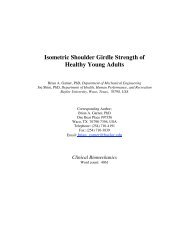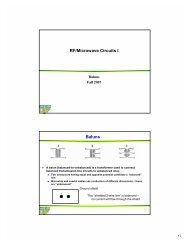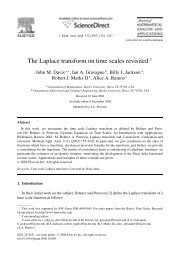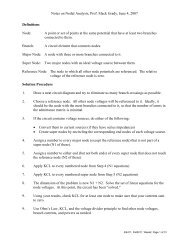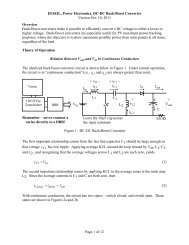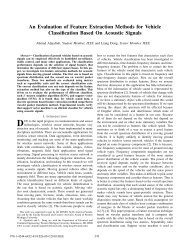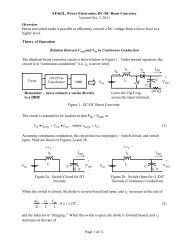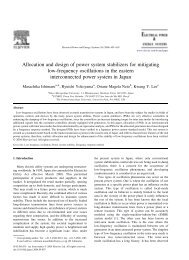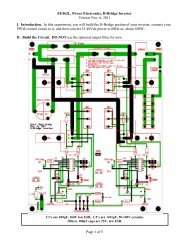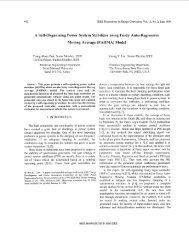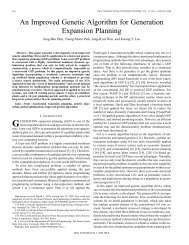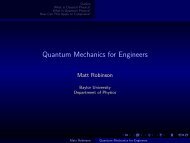Neural Networks Power quality control of an autonomous ... - ECS
Neural Networks Power quality control of an autonomous ... - ECS
Neural Networks Power quality control of an autonomous ... - ECS
You also want an ePaper? Increase the reach of your titles
YUMPU automatically turns print PDFs into web optimized ePapers that Google loves.
<strong>Neural</strong> <strong>Networks</strong> 21 (2008) 1439–1446<br />
Contents lists available at ScienceDirect<br />
<strong>Neural</strong> <strong>Networks</strong><br />
journal homepage: www.elsevier.com/locate/neunet<br />
2008 Special Issue<br />
<strong>Power</strong> <strong>quality</strong> <strong>control</strong> <strong>of</strong> <strong>an</strong> <strong>autonomous</strong> wind–diesel power system based on<br />
hybrid intelligent <strong>control</strong>ler<br />
Hee-S<strong>an</strong>g Ko a , Kw<strong>an</strong>g Y. Lee b , Min-Jae K<strong>an</strong>g c , Ho-Ch<strong>an</strong> Kim c,∗<br />
a Product Development Team/Wind Turbine Division, Samsung Heavy Industries Comp<strong>an</strong>y, Republic <strong>of</strong> Korea<br />
b Department <strong>of</strong> Electrical <strong>an</strong>d Computer Engineering, Baylor University, USA<br />
c Faculty <strong>of</strong> Electrical <strong>an</strong>d Electronics Engineering, Cheju National University, Republic <strong>of</strong> Korea<br />
a r t i c l e<br />
i n f o<br />
a b s t r a c t<br />
Article history:<br />
Received 1 May 2008<br />
Received in revised form<br />
9 October 2008<br />
Accepted 14 October 2008<br />
Keywords:<br />
Wind power generation<br />
Fuzzy <strong>control</strong>ler<br />
<strong>Neural</strong> network inverse model<br />
Wind power generation is gaining popularity as the power industry in the world is moving toward<br />
more liberalized trade <strong>of</strong> energy along with public concerns <strong>of</strong> more environmentally friendly mode <strong>of</strong><br />
electricity generation. The weakness <strong>of</strong> wind power generation is its dependence on nature—the power<br />
output varies in quite a wide r<strong>an</strong>ge due to the ch<strong>an</strong>ge <strong>of</strong> wind speed, which is difficult to model <strong>an</strong>d<br />
predict. The excess fluctuation <strong>of</strong> power output <strong>an</strong>d voltages c<strong>an</strong> influence negatively the <strong>quality</strong> <strong>of</strong><br />
electricity in the distribution system connected to the wind power generation pl<strong>an</strong>t. In this paper, the<br />
authors propose <strong>an</strong> intelligent adaptive system to <strong>control</strong> the output <strong>of</strong> a wind power generation pl<strong>an</strong>t<br />
to maintain the <strong>quality</strong> <strong>of</strong> electricity in the distribution system. The target wind generator is a costeffective<br />
induction generator, while the pl<strong>an</strong>t is equipped with a small capacity energy storage based on<br />
conventional batteries, heater load for co-generation <strong>an</strong>d braking, <strong>an</strong>d a voltage smoothing device such as<br />
a static Var compensator (SVC). Fuzzy logic <strong>control</strong>ler provides a flexible <strong>control</strong>ler covering a wide r<strong>an</strong>ge<br />
<strong>of</strong> energy/voltage compensation. A neural network inverse model is designed to provide compensating<br />
<strong>control</strong> amount for a system. The system c<strong>an</strong> be optimized to cope with the fluctuating market-based<br />
electricity price conditions to lower the cost <strong>of</strong> electricity consumption or to maximize the power sales<br />
opportunities from the wind generation pl<strong>an</strong>t.<br />
© 2008 Elsevier Ltd. All rights reserved.<br />
1. Introduction<br />
In remote areas such as small isl<strong>an</strong>ds, diesel generators are<br />
the main power supply. Diesel fuel has several drawbacks: it is<br />
expensive because tr<strong>an</strong>sportation to remote areas adds extra cost,<br />
<strong>an</strong>d it causes air pollution by engine exhaust. Providing a feasible<br />
economical <strong>an</strong>d environmental solution to diesel generators is<br />
import<strong>an</strong>t. A hybrid system <strong>of</strong> wind power <strong>an</strong>d diesel generators<br />
c<strong>an</strong> benefit isl<strong>an</strong>ds or other isolated communities <strong>an</strong>d increase fuel<br />
savings. Wind is, however, a natural energy source that produces<br />
a fluctuating power output. The excessive fluctuations <strong>of</strong> power<br />
output adversely affect the <strong>quality</strong> <strong>of</strong> power in the distribution<br />
system, particularly frequency <strong>an</strong>d voltage (Feris, 1990; Hunter<br />
& Elliot, 1994). Autonomous renewable energy systems such as<br />
wind, solar, <strong>an</strong>d micro-hydro require <strong>control</strong> methods to maintain<br />
stability due to the real-time variation <strong>of</strong> input energy <strong>an</strong>d load,<br />
while maximizing the use <strong>of</strong> the renewable resources.<br />
Since the early eighties, the wind–diesel <strong>autonomous</strong> power<br />
system (WDAPS) has been accepted <strong>an</strong>d widely used as electricity<br />
∗ Corresponding author. Tel.: +82 64 754 3676; fax: +82 64 756 5281.<br />
E-mail address: hckim@cheju.ac.kr (H.-C. Kim).<br />
generating systems for remote areas. In such cases, the WDAPS<br />
serves <strong>an</strong> entire isolated load <strong>an</strong>d is responsible for maintaining<br />
frequency <strong>an</strong>d voltage stability. The main driving force in WDAPS<br />
design was to secure both fuel saving <strong>an</strong>d reliable power supply.<br />
Usually, diesel generator installed capacity is sized to meet the<br />
peak power dem<strong>an</strong>d, but is used in practice to supply power only<br />
when the wind power output is insufficient to meet the load<br />
dem<strong>an</strong>d (Karaki, Chedid, & Ramad<strong>an</strong>, 2000).<br />
The r<strong>an</strong>dom power disturb<strong>an</strong>ces at the output <strong>of</strong> windturbine<br />
generators c<strong>an</strong> cause relatively large frequency <strong>an</strong>d voltage<br />
fluctuations. In a large power system network, these fluctuations<br />
c<strong>an</strong> have little effect on the overall <strong>quality</strong> <strong>of</strong> the delivered<br />
energy. However, with weak <strong>autonomous</strong> networks, these power<br />
fluctuations c<strong>an</strong> have a marked effect, which must be eliminated<br />
regardless <strong>of</strong> the penetration rate, that is to say, the rate <strong>of</strong> wind<br />
power with respect to the power from a conventional power pl<strong>an</strong>t<br />
in the power system network (Chedid, Karaki, & Chadi, 2000;<br />
P<strong>an</strong>diaraj, Taylor, & Jenkins, 2001). Hence, the <strong>control</strong> <strong>of</strong> the voltage<br />
<strong>an</strong>d frequency <strong>of</strong> a weak-wind–diesel system is considered more<br />
challenging th<strong>an</strong> that in large grids.<br />
The hybrid strategy is motivated with the hope that <strong>an</strong><br />
effective combination <strong>of</strong> <strong>control</strong>lers might improve the <strong>control</strong><br />
perform<strong>an</strong>ce. Since the PID <strong>control</strong>ler is simple to underst<strong>an</strong>d<br />
0893-6080/$ – see front matter © 2008 Elsevier Ltd. All rights reserved.<br />
doi:10.1016/j.neunet.2008.10.004
1440 H.-S. Ko et al. / <strong>Neural</strong> <strong>Networks</strong> 21 (2008) 1439–1446<br />
<strong>an</strong>d tune, it is domin<strong>an</strong>tly used in industrial systems (Hag<strong>an</strong> &<br />
Menhaj, 1994). However, it is difficult to obtain good perform<strong>an</strong>ce<br />
from the PID <strong>control</strong>ler only because a nonlinearity makes <strong>control</strong><br />
with a PID <strong>control</strong>ler difficult unless gain scheduling is used.<br />
Linearizable systems c<strong>an</strong> be <strong>control</strong>led by conventional linear<br />
<strong>control</strong>lers such as state space method, optimal <strong>control</strong>, robust<br />
<strong>control</strong>, model predictive <strong>control</strong>, etc. <strong>Neural</strong> network, fuzzy logic<br />
<strong>an</strong>d genetic algorithm are widely studied to deal with highly<br />
nonlinear systems.<br />
The feedforward <strong>control</strong> concept has attractive features <strong>of</strong><br />
practical relev<strong>an</strong>ce. Since it is assumed that a stabilizing <strong>control</strong>ler<br />
is available in adv<strong>an</strong>ce, the experiment to collect a set <strong>of</strong> training<br />
data sets is easily performed. Another feature is that one c<strong>an</strong><br />
introduce the feedforward signal gradually. In applications where<br />
<strong>an</strong> inappropriate <strong>control</strong> input c<strong>an</strong> cause damage, this c<strong>an</strong> be a s<strong>of</strong>t<br />
<strong>control</strong> strategy (Madsen, 1995).<br />
The main reasons for using feedback are to stabilize unstable<br />
systems <strong>an</strong>d to reduce the influence from possible disturb<strong>an</strong>ces<br />
<strong>an</strong>d model inaccuracies. Using feedback to ensure that the system<br />
rapidly follows ch<strong>an</strong>ges in the reference is not always a good<br />
practice. A rapid reference tracking obtained with feedback<br />
generally has the side effect that the <strong>control</strong>ler becomes highly<br />
sensitive to noise which implies the poor robust properties. To<br />
achieve a satisfying reference tracking without feedback, the<br />
feedforward is applied which is governed only by the reference.<br />
Moreover, feedforward <strong>control</strong> is used for regulation where the<br />
reference attains const<strong>an</strong>t levels for longer periods <strong>of</strong> time.<br />
To speed up the tracking <strong>of</strong> set-point ch<strong>an</strong>ges, a feedforward<br />
<strong>control</strong>ler is typically designed to provide the steady-state value <strong>of</strong><br />
the <strong>control</strong> signal for minimizing tracking error (Haley, Soloway, &<br />
Gold, 1999; Madsen, 1995).<br />
In this paper, fuzzy–neural hybrid <strong>control</strong>ler is proposed <strong>an</strong>d<br />
applied for pitch <strong>control</strong> <strong>of</strong> wind turbine. Fuzzy logic is applied<br />
for designing a feedback <strong>control</strong>ler. <strong>Neural</strong> network inverse model<br />
is designed for a dynamic feedforward <strong>control</strong>ler. Therefore, fast<br />
damping from fuzzy <strong>control</strong>ler <strong>an</strong>d fast reference tracking c<strong>an</strong> be<br />
accomplished.<br />
2. System description<br />
The wind–diesel <strong>autonomous</strong> power system consists <strong>of</strong> the<br />
wind turbine having the induction generator (IG), the diesel engine<br />
(DE), synchronous generator (SG), superconducting magnetic<br />
energy storage (SMES), <strong>an</strong>d the dumpload. When wind generated<br />
power is sufficient to serve the load, the DE is disconnected<br />
from the SG by electromagnetic clutch, <strong>an</strong>d the synchronous<br />
generator acts as a synchronous condenser. The main purpose<br />
<strong>of</strong> the dumpload is to regulate the system frequency. The SG<br />
(with/without diesel) is used for reactive power <strong>control</strong> that is<br />
achieved by the excitation system to regulate voltage. The SG<br />
also contributes the reactive power to compensate the induction<br />
generator.<br />
SMES is a <strong>control</strong> unit for a synchronous machine (Tripathy,<br />
Kal<strong>an</strong>tar, & Balasubram<strong>an</strong>i<strong>an</strong>, 1991). When there is a sudden rise<br />
in the dem<strong>an</strong>d <strong>of</strong> load, the stored energy is immediately released<br />
through the power system. As the governor <strong>an</strong>d pitch <strong>control</strong><br />
mech<strong>an</strong>ism start working to set the power system to the new<br />
operating condition, a SMES unit charges back to its initial value<br />
<strong>of</strong> current. In the case <strong>of</strong> sudden release <strong>of</strong> the loads, a SMES<br />
immediately gets charged towards its full value, thus absorbing<br />
some portion <strong>of</strong> the excess energy in the system, <strong>an</strong>d as the system<br />
returns to its steady state, the excess energy absorbed is released<br />
<strong>an</strong>d SMES current attains its normal value.<br />
Fig. 1 shows the prototype <strong>of</strong> a wind–diesel <strong>autonomous</strong> power<br />
system (Chedid et al., 2000). Generator dynamics model consists <strong>of</strong><br />
a synchronous machine driven by diesel engine through flywheel<br />
<strong>an</strong>d connected in parallel with <strong>an</strong> induction machine driven by a<br />
wind turbine.<br />
Fig. 1. The prototype <strong>of</strong> wind–diesel <strong>autonomous</strong> power system.<br />
Fig. 2. The basic configuration <strong>of</strong> WDAPS.<br />
Blade pitch <strong>control</strong> <strong>of</strong> wind turbine has the potential for<br />
producing the highest level <strong>of</strong> interaction because <strong>of</strong> the presence<br />
<strong>of</strong> both diesel <strong>an</strong>d wind-turbine <strong>control</strong> loops (Tripathy et al.,<br />
1991). The pitch <strong>control</strong> system consists <strong>of</strong> a power measurement<br />
tr<strong>an</strong>sducer, a m<strong>an</strong>ual power set-point <strong>control</strong>, a proportional plus<br />
integral feedback function, <strong>an</strong>d hydraulic actuator, which varies<br />
the pitch <strong>of</strong> the blades. Turbine blade pitch <strong>control</strong> has a signific<strong>an</strong>t<br />
impact on the dynamic behavior <strong>of</strong> the system. Variable pitch<br />
turbines operate efficiently over a wider r<strong>an</strong>ge <strong>of</strong> wind speeds<br />
th<strong>an</strong> fixed pitch machines. The generator dynamics model consists<br />
<strong>of</strong> a synchronous generator driven by a diesel engine through a<br />
flywheel <strong>an</strong>d connected in parallel with <strong>an</strong> induction generator<br />
driven by a wind turbine. The diesel generator will act as a dummy<br />
grid for the wind generator, which is connected in parallel. When<br />
wind power rises above the power set point <strong>an</strong>d SMES unit is fully<br />
charged, the pitch <strong>control</strong> system begins to operate to maintain <strong>an</strong><br />
average power equal to the set point. The study in this paper is<br />
focused on the designing <strong>of</strong> turbine blade pitch <strong>control</strong>ler based<br />
on fuzzy logic <strong>an</strong>d neural network.<br />
The simplified description <strong>of</strong> Fig. 1 is in Fig. 2 with SMES<br />
(Tripathy et al., 1991).<br />
The models <strong>of</strong> the generators are based on the st<strong>an</strong>dard<br />
Park’s tr<strong>an</strong>sformation (Krause, Wasynczuk, & Sudh<strong>of</strong>f, 1986) that<br />
tr<strong>an</strong>sforms all stator variables to a rotor reference frame described<br />
by a direct <strong>an</strong>d quadrature (d–q) axis. The set <strong>of</strong> SG <strong>an</strong>d IG equations<br />
are based on the d–q-axis in accord<strong>an</strong>ce with (International<br />
Electrotechnical Commission, 1975). The SMES model c<strong>an</strong> be found<br />
in Tripathy et al. (1991).<br />
The nonlinear mathematical model <strong>of</strong> the wind–diesel power<br />
system is given in detail in Appendix A. The following considerations<br />
are taken into account to identify component models:<br />
the electrical system is assumed as a perfectly bal<strong>an</strong>ced threephase<br />
system with pure sinusoidal voltage <strong>an</strong>d frequency. High<br />
frequency tr<strong>an</strong>sients in stator variables are neglected, which indicates<br />
that the stator voltage <strong>an</strong>d currents are allowed to ch<strong>an</strong>ge<br />
inst<strong>an</strong>tly. This is because this paper is focused on the tr<strong>an</strong>sient period<br />
instead <strong>of</strong> sub-tr<strong>an</strong>sient period. Damper-winding models are<br />
ignored because their effect appears mainly in a grid-connected
H.-S. Ko et al. / <strong>Neural</strong> <strong>Networks</strong> 21 (2008) 1439–1446 1441<br />
Fig. 3. Membership function <strong>of</strong> error <strong>an</strong>d ch<strong>an</strong>ge in error.<br />
system or a system with several synchronous generators running<br />
in parallel. The different component models are <strong>of</strong> equal level <strong>of</strong><br />
complexity.<br />
3. Fuzzy–neural hybrid <strong>control</strong><br />
3.1. Feedback <strong>control</strong>ler based on fuzzy logic<br />
Fuzzy <strong>control</strong> systems are rule-based systems in which a set<br />
<strong>of</strong> fuzzy rules represents a <strong>control</strong> decision mech<strong>an</strong>ism to adjust<br />
the effects <strong>of</strong> certain system conditions. Fuzzy <strong>control</strong>ler is based<br />
on the linguistic relationships or rules that define the <strong>control</strong><br />
laws <strong>of</strong> a process between input <strong>an</strong>d output (Passino, 1997; Yen<br />
& L<strong>an</strong>gari, 1999). This feature draws attention toward a fuzzy<br />
<strong>control</strong>ler due to its nonlinear characteristics <strong>an</strong>d no need for <strong>an</strong><br />
accurate system modeling. The fuzzy <strong>control</strong>ler consists <strong>of</strong> rule<br />
base, which represents a fuzzy logic qu<strong>an</strong>tification <strong>of</strong> the expert’s<br />
linguistic description <strong>of</strong> how to achieve good <strong>control</strong>, fuzzification<br />
<strong>of</strong> actual input values, fuzzy inference, <strong>an</strong>d defuzzification <strong>of</strong> fuzzy<br />
output. When the expert’s linguistic description is not available,<br />
fuzzy <strong>control</strong>ler still c<strong>an</strong> be designed by using the measurement <strong>of</strong><br />
real-time input/output data (Park, Moon, & Lee, 1995, 1996)<br />
In this paper, a total <strong>of</strong> 121 rules are used for the power system<br />
under study. The general form <strong>of</strong> the fuzzy rule is given in the<br />
if–then form as follows:<br />
if x(k) is A <strong>an</strong>d ∆x(k) is B, then y(k) is C, (1)<br />
where<br />
x, ∆x: input signals,<br />
y: <strong>control</strong>ler output,<br />
A, B, C: linguistic variables.<br />
The linguistic values extracted from the experimental knowledge<br />
are NH (negative high), NL (negative large), NB (negative big),<br />
NM (negative medium), NS (negative small), ZE (zero), PS (positive<br />
small), PM (positive medium), PB (positive big), PL (positive large),<br />
<strong>an</strong>d PH (positive high).<br />
In the power system under study, generator power deviation<br />
(P) is chosen for the input <strong>of</strong> a fuzzy <strong>control</strong>ler. The linguistic<br />
descriptions provide experimental expressions <strong>of</strong> the expert for<br />
a <strong>control</strong> decision-making process <strong>an</strong>d each linguistic variable is<br />
represented as tri<strong>an</strong>gular membership functions shown in Figs. 3<br />
<strong>an</strong>d 4. In the fuzzy <strong>control</strong>ler, the input normalization factors are<br />
chosen to represent the proper membership qu<strong>an</strong>tifications <strong>of</strong><br />
linguistic values. In addition, normalization factors c<strong>an</strong> be used to<br />
yield the desired response <strong>of</strong> the fuzzy <strong>control</strong>ler. g 1 , g 2 st<strong>an</strong>d for<br />
a normalization factor for input <strong>of</strong> fuzzy <strong>control</strong>ler <strong>an</strong>d g 0 st<strong>an</strong>ds<br />
for a denormalization factor for output <strong>of</strong> fuzzy <strong>control</strong>ler. Fig. 3<br />
shows the membership function for error <strong>an</strong>d ch<strong>an</strong>ge in error <strong>an</strong>d<br />
Fig. 4 depicts the membership function for output.<br />
In Figs. 3 <strong>an</strong>d 4, the membership functions are overlapped with<br />
each other to smooth a fuzzy system output <strong>an</strong>d a fuzzy <strong>control</strong>ler<br />
is designed to regulate a system smoothly when <strong>an</strong> error <strong>an</strong>d a<br />
ch<strong>an</strong>ge in error are near zero. The rules are established to <strong>control</strong><br />
tr<strong>an</strong>sient stability problem for all possible cases. Tables 1 <strong>an</strong>d 2<br />
show the inference rule table for two input fuzzy variables in<br />
negative <strong>an</strong>d positive sides <strong>of</strong> ch<strong>an</strong>ge in error, respectively.<br />
Fig. 4. Membership function <strong>of</strong> output.<br />
Table 1<br />
Inference rule table in negative side <strong>of</strong> ch<strong>an</strong>ge in error.<br />
Error<br />
Ch<strong>an</strong>ge in error<br />
−1 −0.8 −0.6 −0.4 −0.2 0<br />
−1 −1 −1 −1 −1 −1 −1<br />
−0.8 −1 −1 −1 −1 −1 −0.7<br />
−0.6 −1 −1 −1 −1 −0.7 −0.4<br />
−0.4 −1 −1 −1 −0.7 −0.4 −0.2<br />
−0.2 −1 −1 −0.7 −0.4 −0.2 −0.1<br />
0 −1 −0.7 −0.4 −0.2 −0.1 0<br />
0.2 −0.7 −0.4 −0.2 −0.1 0 0.1<br />
0.4 −0.4 −0.2 −0.1 0 0.1 0.2<br />
0.6 −0.2 −0.1 0 0.1 0.2 0.4<br />
0.8 −0.1 0 0.1 0.2 0.4 0.7<br />
1 0 0.1 0.2 0.4 0.7 1<br />
Table 2<br />
Inference rule table in positive side <strong>of</strong> ch<strong>an</strong>ge in error.<br />
Error<br />
Ch<strong>an</strong>ge in error<br />
0.2 0.4 0.6 0.8 1<br />
−1 −1 −1 −1 −1 −1<br />
−0.8 −0.4 −0.2 −0.1 0 −0.7<br />
−0.6 −0.2 −0.1 0 0.1 −0.4<br />
−0.4 −0.1 0 0.1 0.2 −0.2<br />
−0.2 0 0.1 0.2 0.4 −0.1<br />
0 0.1 0.2 0.4 0.7 0<br />
0.2 0.2 0.4 0.7 1 0.1<br />
0.4 0.4 0.7 1 1 0.2<br />
0.6 0.7 1 1 1 0.4<br />
0.8 1 1 1 1 0.7<br />
1 1 1 1 1 1<br />
It is required to find the fuzzy region for the output for each rule.<br />
The centroid or the center <strong>of</strong> gravity defuzzification method (Yen &<br />
L<strong>an</strong>gari, 1999) is used which calculates the most typical crisp value<br />
<strong>of</strong> the fuzzy set <strong>an</strong>d ‘‘y is C’’ in Eq. (1) c<strong>an</strong> be expressed by (2).<br />
∑<br />
µ A (y i ) × y i<br />
i<br />
y = ∑<br />
(2)<br />
µ A (y i )<br />
i<br />
where µ A is a degree <strong>of</strong> the membership function.<br />
3.2. Feedforward compensator based on neural network inverse<br />
model<br />
A neural network c<strong>an</strong> model <strong>an</strong> input/output relationship <strong>of</strong><br />
a dynamic system. A direct or forward model is a mapping that<br />
maps a system input to a system output. An inverse model, on<br />
the other h<strong>an</strong>d, is <strong>an</strong> inverse mapping that maps a system output<br />
to a system input. In particular, if one sets the output to be the<br />
reference, then the inverse model could give a desired input for the<br />
output to follow the reference or set point. The concept <strong>of</strong> inverse<br />
model was used in designing feedforward <strong>control</strong>s for dynamic<br />
systems (Harnold, Lee, Lee, & Park, 1998; Kawato, Furukawa, &<br />
Suzuki, 1987; Nak<strong>an</strong>ishi & Schaal, 2004; Park, Choi, & Lee, 1996).<br />
Kawato et al. (1987) applied the concept <strong>of</strong> inverse-dynamics
1442 H.-S. Ko et al. / <strong>Neural</strong> <strong>Networks</strong> 21 (2008) 1439–1446<br />
Fig. 5. Training mode <strong>of</strong> NNIM.<br />
Fig. 7. The fuzzy–neural hybrid <strong>control</strong>.<br />
Fig. 6. <strong>Neural</strong> Network Inverse Model (NNIM).<br />
model to <strong>control</strong> a three-joint robotic m<strong>an</strong>ipulator represented in<br />
a continuous nonlinear kinematics model. In view <strong>of</strong> the fact that<br />
the inverse-dynamics model only gives the ideal computed torque,<br />
feedback-error-learning scheme was utilized to compensate for<br />
the output error. Nak<strong>an</strong>ishi <strong>an</strong>d Schaal (2004) reformulated the<br />
feedback-learning scheme for a class <strong>of</strong> nonlinear systems from a<br />
viewpoint <strong>of</strong> the nonlinear adaptive <strong>control</strong> theory. Park <strong>an</strong>d Choi<br />
et al. (1996) <strong>an</strong>d Harnold et al. (1998) approached the problem<br />
from the viewpoint <strong>of</strong> discrete-time model <strong>of</strong> the nonlinear system,<br />
thus avoiding the issues <strong>of</strong> the invertibility <strong>of</strong> a nonlinear model.<br />
A two layer neural network is applied to obtain a dynamic<br />
feedforward compensator (Haykin, 1998). In general, the output<br />
<strong>of</strong> a system c<strong>an</strong> be described with a function or a mapping <strong>of</strong> the<br />
pl<strong>an</strong>t input–output history (Haykin, 1998; Ng, 1997). For a singleinput<br />
single-output (SISO) discrete-time system, the mapping c<strong>an</strong><br />
be written in the form <strong>of</strong> a nonlinear function as follows:<br />
y(k + 1) = f (y(k), y(k − 1), . . . , y(k − n),<br />
u(k), u(k − 1), . . . , u(k − m)). (3)<br />
Solving for the <strong>control</strong>, (3) c<strong>an</strong> be represented as the following:<br />
u(k) = g(y(k + 1), y(k), y(k − 1), y(k − 2), . . . , y(k − n),<br />
u(k − 1), u(k − 2), u(k − 3), . . . , u(k − m)), (4)<br />
which is a nonlinear inverse mapping <strong>of</strong> (3). The objective <strong>of</strong> the<br />
<strong>control</strong> problem is to find a <strong>control</strong> sequence, which will drive a<br />
system to <strong>an</strong> arbitrary reference trajectory. This c<strong>an</strong> be achieved by<br />
replacing y(k+1) in (4) with reference output y ref or the temporary<br />
target y r (k + 1), evaluated by<br />
y r (k + 1) = y(k) + α(y ref − y(k)), (5)<br />
where α is the target ratio const<strong>an</strong>t (0 < α ≤ 1). The value <strong>of</strong> α<br />
describes the rate with which the present output y(k) approaches<br />
the reference output value, <strong>an</strong>d thus has a positive value between<br />
0 <strong>an</strong>d 1 (Park et al., 1995; Park & Moon et al., 1996). In Fig. 5,<br />
the training mode is introduced, where ∆ denotes the vector <strong>of</strong><br />
delay sequence data. Fig. 6 shows the neural network inverse<br />
model (NNIM) in training mode. All activation functions in the<br />
hidden layer are t<strong>an</strong>h(x) (described as f j in Fig. 6) <strong>an</strong>d the activation<br />
function in output layer is x (depicted as F i in Fig. 6).<br />
The output <strong>of</strong> the NNIM c<strong>an</strong> be represented as<br />
[<br />
nh<br />
(<br />
∑<br />
n<br />
) ]<br />
ϕ∑<br />
û i (k) = F i W ij f j w jl ¯ϕ + w j0 + W i0 , (6)<br />
where<br />
j=1<br />
l=1<br />
¯ϕ = [y(k + 1), y(k), . . . , y(k − n), u(k − 1), . . . , u(k − m)] T<br />
<strong>an</strong>d ¯ϕ = [ϕ 1 , ϕ 2 , ϕ 3 , . . . , ϕ n ϕ ]T<br />
w jl : weight between input <strong>an</strong>d hidden layers,<br />
n h , n ϕ : number <strong>of</strong> hidden neurons <strong>an</strong>d external input,<br />
W ij : weight between hidden <strong>an</strong>d output layers.<br />
The above neural network inverse model is trained based on the<br />
input–output data described in Fig. 5. To train the neural network<br />
inverse model, the Levenberg–Marquardt method is applied which<br />
is fast <strong>an</strong>d robust (Haykin, 1998; Madsen, 1995; Ng, 1997). The<br />
trained NNIM is used as a feedforward compensator.<br />
The total <strong>control</strong> scheme is indicated in Fig. 7. In the fuzzy<br />
<strong>control</strong>ler, the input normalization factors are chosen to represent<br />
the proper membership qu<strong>an</strong>tifications <strong>of</strong> linguistic values. In<br />
addition, normalization factors c<strong>an</strong> be used to yield the desired<br />
response <strong>of</strong> the fuzzy <strong>control</strong>ler. The symbol ∆ denotes the vector<br />
<strong>of</strong> delay sequence data. The total <strong>control</strong> input is u(k) = u fb (k) +<br />
u ff (k). The feedback <strong>control</strong> u fb (k) is the output <strong>of</strong> the fuzzy<br />
<strong>control</strong>ler <strong>an</strong>d the output <strong>of</strong> the feedforward <strong>control</strong>ler, u ff (k), c<strong>an</strong><br />
be represented as the following:<br />
u ff (k) = g(y r (k + 1), y r (k), y r (k − 1), . . . , y r (k − n),<br />
u fb (k − 1), u fb (k − 2), . . . , u fb (k − m)). (7)<br />
In Fig. 7, once a signal <strong>of</strong> a feedforward compensator is given<br />
to the <strong>control</strong> system, the fuzzy <strong>control</strong>ler provides a signal that<br />
minimizes the error between the system output <strong>an</strong>d its set point.<br />
This <strong>control</strong> scheme c<strong>an</strong> be a s<strong>of</strong>t way <strong>of</strong> generating a <strong>control</strong> signal<br />
to minimize the tracking error <strong>an</strong>d improve system perform<strong>an</strong>ce<br />
in the sense that the compensating signal is given in adv<strong>an</strong>ce<br />
(Madsen, 1995). This implies the improvement <strong>of</strong> the existing<br />
PID-type <strong>control</strong>ler, which is the main purpose <strong>of</strong> a feedforward<br />
<strong>control</strong>ler in a hybrid <strong>control</strong> scheme.<br />
4. Simulation<br />
First, a fuzzy <strong>control</strong>ler is designed for a feedback <strong>control</strong>ler<br />
<strong>an</strong>d a neural network inverse model is obtained for a feedforward<br />
compensator. In this paper, α is 0.1 <strong>an</strong>d g 1 , g 2 , g 0 are 5,<br />
50, <strong>an</strong>d 5, respectively, determined by trial <strong>an</strong>d error. The<br />
Levenberg–Marquardt method is applied to train a neural network<br />
inverse model. The sampling time is 0.01 s. for the proposed <strong>control</strong><br />
action. The training is carried out by giving varying white noise<br />
signals. Firstly, before training, fuzzy <strong>control</strong> is implemented with<br />
the pl<strong>an</strong>t. Secondly, white noise signal is inserted into the fuzzy<br />
<strong>control</strong>ler <strong>an</strong>d data set is obtained, using noise signal as input <strong>an</strong>d<br />
pl<strong>an</strong>t output as output. Then, the neural network inverse model
H.-S. Ko et al. / <strong>Neural</strong> <strong>Networks</strong> 21 (2008) 1439–1446 1443<br />
Fig. 8. Comparison <strong>of</strong> system response among PI, FC, <strong>an</strong>d FNHC.<br />
(NNIM) is trained by setting the noise signal as output <strong>an</strong>d the pl<strong>an</strong>t<br />
output as input <strong>of</strong> the NNIM.<br />
The proposed fuzzy–neural hybrid <strong>control</strong>ler is tested in a<br />
wind–diesel <strong>autonomous</strong> power system (WDAPS). Two cases are<br />
considered: first, the sudden step load increase <strong>of</strong> 0.01 per-unit<br />
(p.u.) when SMES is in discharging mode (rectifier mode); second,<br />
when the SMES is fully discharged <strong>an</strong>d there is a sudden step load<br />
increase. In this case, SMES is in recharging mode (inverter mode).<br />
(The ‘‘(p.u.)’’ st<strong>an</strong>ds for ‘‘per-unit’’. It is a normalized value with<br />
respect to a base or reference value.)<br />
4.1. Case 1: A sudden step load increase<br />
The load is suddenly increased by 0.01 p.u. The SMES<br />
releases the charged current (2 p.u.). The governor <strong>an</strong>d pitch<br />
mech<strong>an</strong>ism start operating for charging current <strong>of</strong> SMES <strong>an</strong>d<br />
damping <strong>of</strong> WDAPS. Fig. 8 shows improvement <strong>of</strong> the system<br />
frequency oscillations <strong>an</strong>d power deviations, where PI st<strong>an</strong>ds for<br />
conventional proportional–integral <strong>control</strong>ler <strong>an</strong>d FC st<strong>an</strong>ds for<br />
fuzzy logic feedback <strong>control</strong>ler.<br />
Fig. 9. Comparison <strong>of</strong> system response among PI, FC, <strong>an</strong>d FNHC.<br />
4.2. Case 2: Sudden step load increase with fully discharged SMES<br />
In this case, the SMES is fully discharged (0 p.u.). Then, the SMES<br />
needs to recharge current to the set point (2 p.u.). The wind power<br />
generation from the wind turbine is assumed to be not sufficient.<br />
Fig. 9 also shows that the FNHC perform<strong>an</strong>ce is much better th<strong>an</strong><br />
the PI <strong>an</strong>d the FC.<br />
5. Conclusion<br />
In this paper, the fuzzy–neural hybrid <strong>control</strong>ler for electricity<br />
<strong>quality</strong> <strong>control</strong> <strong>of</strong> wind power generation pl<strong>an</strong>ts is presented.<br />
The main idea <strong>of</strong> hybrid <strong>control</strong> is that the dynamic<br />
feedforward <strong>control</strong> c<strong>an</strong> be used for improving the reference<br />
tracking while feedback is used for stabilizing the system <strong>an</strong>d<br />
for suppressing disturb<strong>an</strong>ces. Feedforward <strong>control</strong>ler is a neural<br />
network inverse model (NNIM), which is trained by the Levenberg–Marquardt<br />
method, <strong>an</strong>d feedback <strong>control</strong>ler is a fuzzy<br />
<strong>control</strong>ler.
1444 H.-S. Ko et al. / <strong>Neural</strong> <strong>Networks</strong> 21 (2008) 1439–1446<br />
The Fuzzy-NNIM was tested in a wind–diesel <strong>autonomous</strong><br />
power system <strong>an</strong>d compared with the conventional PI <strong>an</strong>d the<br />
fuzzy <strong>control</strong>ler. In all cases, the Fuzzy-NNIM out-performed the<br />
conventional PI <strong>an</strong>d the fuzzy <strong>control</strong>ler. The Fuzzy-NNIM provides<br />
quite small frequency deviation. Thus, the usefulness <strong>of</strong> Fuzzy-<br />
NNIM-based <strong>control</strong>ler design is demonstrated.<br />
Appendix A. Wind–diesel power system model (International<br />
Electrotechnical Commission, 1975; Krause et al., 1986)<br />
A.1. Diesel-engine–Synchronous-generator model (salient pole)<br />
˙Q f = 1 τ c<br />
(<br />
−Qf + Q d (t − τ d ) )<br />
˙θ cl = ω d − ω s<br />
˙ω d = 1 J d<br />
(<br />
kc k v Q f − (D d + D cl )ω d + D cl ω s − k v p o − C cl θ cl<br />
)<br />
˙ψ f = 1 ( )<br />
τ ′ −ψf + L md I sd + Efd<br />
do<br />
˙ω s = 1 (C cl θ cl + D cl ω d − T s − (D cl + D s )ω s )<br />
J s<br />
⎡<br />
R s −ω s L ′ ⎤ ⎡ ⎤ ⎡ ⎤<br />
d<br />
1 0 I sq 0 0 [ ]<br />
⎢ω s L q R s 0 1 ⎥ ⎢I sd ⎥ ⎢0 0⎥<br />
Vbq<br />
⎣<br />
R 1 −ω s L 1 −1 0<br />
⎦ ⎣<br />
V<br />
⎦ + ⎣<br />
sq 1 0<br />
⎦<br />
V bd<br />
ω s L 1 R 1 0 −1 V sd 0 1<br />
⎡ ⎤<br />
L md<br />
ω s ψ f<br />
L f<br />
= ⎢0<br />
⎥<br />
⎣ ⎦<br />
0<br />
0<br />
where T s = − L md<br />
L f<br />
ψ f I sq − (L ′ d − L q)I sq I sd .<br />
A.2. Induction generator model (squirrel-cage rotor)<br />
˙ψ rq = 1 τ ′ o<br />
(−ψ rq + L m I aq ) + ω b (ω s − ω a )ψ rd<br />
˙ψ rd = 1 (10)<br />
(−ψ<br />
τ ′ rd + L m I ad ) − ω b (ω s − ω a )ψ rq<br />
o<br />
⎡<br />
R a −ω s L ′ ⎤ ⎡ ⎤<br />
s<br />
1 0<br />
I<br />
⎢ω s L ′ aq<br />
s<br />
R a 0 1 ⎥ ⎢I ad ⎥<br />
⎣<br />
r 2 −ω s L 2 (ω 2 s C aL 2 − 1) ω<br />
⎦ ⎣<br />
s R 2 C a V<br />
⎦<br />
aq<br />
ω s L 2 R 2 −ω s R 2 C a (ω 2 s C aL 2 − 1) V ad<br />
⎡ ⎤<br />
⎡ ⎤<br />
0 0<br />
⎢0 0⎥<br />
+ ⎣<br />
1 0<br />
⎦<br />
0 1<br />
[ ]<br />
Vbq<br />
=<br />
V bd<br />
(8)<br />
(9)<br />
L m<br />
ω s ψ rd<br />
L r L m<br />
⎢−ω s ψ rq<br />
⎣ L ⎥<br />
r ⎦ . (11)<br />
0<br />
0<br />
A.3. Wind-turbine drive train model (shaft between rotor turbine <strong>an</strong>d<br />
the IG)<br />
˙θ c = ω t − ω a<br />
˙ω t = 1 ( )<br />
1<br />
J t 2 C vw<br />
3<br />
pρA r − C c θ c − (D t + D c )ω t + D c ω a<br />
ω t<br />
˙ω a = 1 J a<br />
(C c θ c + D c ω t − (D a + D c )ω a − T a ) .<br />
A.4. Network model<br />
(12)<br />
I sq + I iq − I lq − I ac,q = 0, I sd + I id − I ld − I ac,d = 0 (13)<br />
where<br />
I lq =<br />
(<br />
R3<br />
R 2 3 + X 2 3<br />
I ld = − X 3<br />
V bq +<br />
R 2 + 3 X 2 3<br />
<strong>an</strong>d<br />
+ 1<br />
r dump<br />
)<br />
V bq + X 3<br />
(<br />
R3<br />
R 2 3 + X 2 3<br />
V bd<br />
R 2 + 3 X 2 3<br />
+ 1 )<br />
V bd<br />
r dump<br />
I iq = I aq + ω s C a V ad , I id = I ad − ω s C a V aq ,<br />
−ω s C filt<br />
1<br />
I ac,q =<br />
1 − ωs 2C V cd +<br />
filtL filt 1 − ωs 2C I cq ,<br />
filtL filt<br />
I ac,d =<br />
A.5. Symbols<br />
ω s C filt<br />
1<br />
1 − ωs 2C V cq +<br />
filtL filt 1 − ωs 2C I cd .<br />
filtL filt<br />
C a , ω a : capacitor b<strong>an</strong>k <strong>an</strong>d <strong>an</strong>gular speed <strong>of</strong> wind turbine<br />
L md , L ′ d<br />
: d-axis field mutual induct<strong>an</strong>ce <strong>an</strong>d tr<strong>an</strong>sient induct<strong>an</strong>ce.<br />
I lq , I ld : current component <strong>of</strong> the load<br />
V sq , V sd : stator terminal voltage components <strong>of</strong> SG<br />
E fd , ψ f : field voltage <strong>an</strong>d field flux linkage <strong>of</strong> SG<br />
ω s , ω t : bus frequency (or <strong>an</strong>gular speed <strong>of</strong> SG) <strong>an</strong>d IG rotor<br />
τ ′ , τ ′ do o<br />
: tr<strong>an</strong>sient open circuit time const<strong>an</strong>t<br />
T s , T a : air gap torque <strong>of</strong> SG <strong>an</strong>d IG<br />
J s , D s : inertia <strong>an</strong>d frictional damping <strong>of</strong> SG<br />
ψ rq , ψ rd : rotor flux linkage components <strong>of</strong> SG<br />
R s , R a , L ′, s L r: stator <strong>an</strong>d rotor resist<strong>an</strong>ce <strong>an</strong>d induct<strong>an</strong>ce <strong>of</strong> SG<br />
R 1 , R 2 , L 1 , L 2 : resist<strong>an</strong>ce <strong>an</strong>d react<strong>an</strong>ce between SG <strong>an</strong>d IG <strong>an</strong>d bus<br />
I sq , I sd , I iq , I id : current component <strong>of</strong> SG <strong>an</strong>d IG into the bus<br />
I aq ,I ad , V aq ,V ad : stator terminal current <strong>an</strong>d voltage <strong>of</strong> IG<br />
L q , L d , L f , L m : q-, d-axis, field, <strong>an</strong>d mutual induct<strong>an</strong>ce <strong>of</strong> SG<br />
I cq ,I cd , V cq , V cd :AC side current <strong>an</strong>d voltage <strong>of</strong> the converter<br />
I ac,q , I ac,d : the AC side current before the filters<br />
Q f : fuel flow rate into the combustion chamber<br />
Q d : fuel flow rate at the governor chamber valve<br />
p o : zero torque pressure when running idle<br />
τ d : time delay <strong>of</strong> combustion<br />
k v : stroke volume <strong>of</strong> the engine<br />
k c : a const<strong>an</strong>t describing efficiency <strong>of</strong> combustion<br />
θ cl : torsional <strong>an</strong>gle between the engine <strong>an</strong>d the generator<br />
shaft<br />
ρ: air density<br />
C p : power efficient coefficient<br />
A r : swept area <strong>of</strong> the rotor<br />
v w : wind velocity<br />
R 3 , X 3 : equivalent load resist<strong>an</strong>ce <strong>an</strong>d react<strong>an</strong>ce<br />
A.6. Parameter base values<br />
Terms Symbols Parameters<br />
ω b<br />
Angular<br />
2π50 rad/s<br />
speed/frequency<br />
<strong>Power</strong> S b = P b = Q b 55 000 VA<br />
Line AC voltage V b 230 V (rms)<br />
DC voltage V dc 230 V<br />
AC current I b = S b / √ 3V b 138 A<br />
DC current I dc = S b /V dc 239 A<br />
Resist<strong>an</strong>ce R base = V 2 b /S b 0.96 <br />
Induct<strong>an</strong>ce L base = R base /ω b 3.06 mH<br />
Capacit<strong>an</strong>ce C base = 1/(R base ω b ) 3.31 mF<br />
Torque T b = S b /ω b 175.1 N m<br />
Moment <strong>of</strong> inertia J base = S b /ω 2 b<br />
0.557 kg m 2 /s<br />
Torsional stiffness C T,base = T base /rad 175.1 N m/rad<br />
Torsional damping D T,base = T base /ω b 0.557 N ms/rad
H.-S. Ko et al. / <strong>Neural</strong> <strong>Networks</strong> 21 (2008) 1439–1446 1445<br />
Fig. 10. The structure <strong>of</strong> the dumpload with binary resistor sizing.<br />
Hag<strong>an</strong>, M. T., & Menhaj, M. B. (1994). Training feedforward networks with<br />
the Marquardt algorithm. IEEE Tr<strong>an</strong>sactions on <strong>Neural</strong> <strong>Networks</strong>, 5(6),<br />
989–993.<br />
Haley, P., Soloway, D., & Gold, B. (1999). Real-time adaptive <strong>control</strong> using neural<br />
generalized <strong>control</strong>. In Proc. Americ<strong>an</strong> <strong>control</strong> conference (pp. 4278-4282).<br />
Haykin, S. (1998). <strong>Neural</strong> networks: A comprehensive foundation. New Jersey:<br />
Prentice Hall.<br />
Harnold, C. -L. -M., Lee, K. Y., Lee, J. -H., & Park, Y. -M. (1998). Free model based<br />
adaptive inverse <strong>control</strong> for dynamic systems. In Proc. the 37th IEEE conference<br />
on decision <strong>an</strong>d <strong>control</strong> (p. 507).<br />
Hunter, R., & Elliot, G. (1994). Wind-diesel systems. New York: Cambridge<br />
University.<br />
International Electrotechnical Commission, (1975). Publication 34-10, Rotating<br />
electrical machines, Part 10: Conventions for description <strong>of</strong> synchronous<br />
machines. Geneva.<br />
Karaki, S. H., Chedid, R. B., & Ramad<strong>an</strong>, R. (2000). Probabilistic production costing <strong>of</strong><br />
diesel-wind energy conversion systems. IEEE Tr<strong>an</strong>sactions on Energy Conversion,<br />
15(3), 284–289.<br />
Kawato, M., Furukawa, K., & Suzuki, R. (1987). A hierarchical neural-network model<br />
for <strong>control</strong> <strong>an</strong>d learning <strong>of</strong> voluntary movement. Biological Cybernetics, 57,<br />
169–185.<br />
Krause, P. C., Wasynczuk, O., & Sudh<strong>of</strong>f, S. D. (1986). Analysis <strong>of</strong> electrical machinery.<br />
New York: McGraw-Hill.<br />
Madsen, P. P. (1995) <strong>Neural</strong> network for optimization <strong>of</strong> existing <strong>control</strong><br />
systems. In Proc. IEEE international joint conference on neural networks<br />
(pp. 1496–1501).<br />
Nak<strong>an</strong>ishi, J., & Schaal, S. (2004). Feedback error learning <strong>an</strong>d nonlinear adaptive<br />
<strong>control</strong>. <strong>Neural</strong> <strong>Networks</strong>, 17, 1453–1465.<br />
Ng, G. W. (1997). Application <strong>of</strong> <strong>Neural</strong> <strong>Networks</strong> to adaptive <strong>control</strong> <strong>of</strong> nonlinear<br />
systems. John Wiley <strong>an</strong>d Sons Inc.<br />
P<strong>an</strong>diaraj, K., Taylor, P., & Jenkins, N. (2001). Distributed load <strong>control</strong> <strong>autonomous</strong><br />
renewable energy systems. IEEE Tr<strong>an</strong>sactions on Energy Conversion, 16(1),<br />
14–19.<br />
Park, Y. M., Choi, M. S., & Lee, K. Y. (1996). An optimal tracking neuro-<strong>control</strong>ler<br />
for nonlinear dynamic systems. IEEE Tr<strong>an</strong>sactions on <strong>Neural</strong> <strong>Networks</strong>, 7(5),<br />
1099–1110.<br />
Park, Y. M., Moon, U. C., & Lee, K. Y. (1995). A self-org<strong>an</strong>izing fuzzy logic <strong>control</strong>ler for<br />
dynamic systems using fuzzy auto-regressive moving average (FARMA) model.<br />
IEEE Tr<strong>an</strong>sactions on Fuzzy Systems, 3(1), 75–82.<br />
Park, Y. M., Moon, U. C., & Lee, K. Y. (1996). A self-org<strong>an</strong>izing power system stabilizer<br />
using fuzzy auto-regressive moving average (FARMA) model. IEEE Tr<strong>an</strong>sactions<br />
on Energy Conversion, 11(2), 442–448.<br />
Passino, K. M. (1997). Fuzzy <strong>control</strong>: Theory <strong>an</strong>d applications. Addison Wesley<br />
Publishing.<br />
Tripathy, S. C., Kal<strong>an</strong>tar, M., & Balasubram<strong>an</strong>i<strong>an</strong>, R. (1991). Dynamics <strong>an</strong>d stability<br />
<strong>of</strong> wind <strong>an</strong>d diesel turbine generator with superconducting magnetic energy<br />
storage unit on <strong>an</strong> isolated power system. IEEE Tr<strong>an</strong>sactions on Energy<br />
Conversion, 6(4), 579–585.<br />
Yen, J., & L<strong>an</strong>gari, R. (1999). Fuzzy logic: Intelligence, <strong>control</strong>, <strong>an</strong>d information. Prentice<br />
Hall.<br />
Fig. 11.<br />
Appendix B. Dumpload model<br />
Tr<strong>an</strong>sistor switching signal.<br />
Fig. 10 is the three-phase dumpload, where each phase<br />
consists <strong>of</strong> 7 tr<strong>an</strong>sistor-<strong>control</strong>led resistor b<strong>an</strong>ks with binary<br />
resistor sizing in order to minimize qu<strong>an</strong>tum effects <strong>an</strong>d provide<br />
more-or-less linear resolution. Fig. 11 shows how the tr<strong>an</strong>sistors<br />
are switched to meet the required power. For example, based on<br />
the rated AC line voltage <strong>of</strong> 230 V <strong>an</strong>d per-phase resist<strong>an</strong>ce <strong>of</strong><br />
R (=120 ), if the required dumpload power from the dumpload<br />
<strong>control</strong>ler is 880 W, Step-2 is identified, <strong>an</strong>d only switch S 2 is<br />
turned ON.<br />
References<br />
Chedid, R. B., Karaki, S. H., & Chadi, E. C. (2000). Adaptive fuzzy <strong>control</strong> for winddiesel<br />
weak power systems. IEEE Tr<strong>an</strong>sactions on Energy Conversion, 15(1),<br />
71–78.<br />
Feris, L. L. (1990). Wind energy conversion system. New Jersey: Prentice Hall.<br />
Hee-S<strong>an</strong>g Ko received his B.S. degree in Electrical<br />
Engineering from Cheju National University, Jeju, Korea,<br />
in 1996, his M.Sc. degree in Electrical Engineering<br />
from Pennsylv<strong>an</strong>ia State University, University Park,<br />
USA, in 2000, <strong>an</strong>d his Ph.D. in Electrical <strong>an</strong>d Computer<br />
Engineering from the University <strong>of</strong> British Columbia,<br />
V<strong>an</strong>couver, C<strong>an</strong>ada, in 2006. He is a researcher in the<br />
cooperation pl<strong>an</strong>ning team at Samsung Heavy Industries<br />
Comp<strong>an</strong>y, Korea. His research interests include wind<br />
power generation, power system voltage <strong>an</strong>d tr<strong>an</strong>sient<br />
stability, data processing for power system security<br />
<strong>an</strong>alysis, electricity market <strong>an</strong>alysis, <strong>an</strong>d system identification.<br />
Kwnag Y. Lee received his B.S. degree in Electrical<br />
Engineering from Seoul National University, Korea, in<br />
1964, M.S. degree in Electrical Engineering from North<br />
Dakota State University, Fargo, in 1968, <strong>an</strong>d Ph.D.<br />
degree in System Science from Michig<strong>an</strong> State University,<br />
East L<strong>an</strong>sing, in 1971. He has been with Michig<strong>an</strong><br />
State, Oregon State, Univ. <strong>of</strong> Houston, the Pennsylv<strong>an</strong>ia<br />
State University, <strong>an</strong>d Baylor University where he is<br />
currently a Pr<strong>of</strong>essor <strong>an</strong>d Chair <strong>of</strong> Electrical <strong>an</strong>d Computer<br />
Engineering. His interests include power system <strong>control</strong>,<br />
operation, pl<strong>an</strong>ning, <strong>an</strong>d intelligent system applications<br />
to power systems. Dr. Lee is a Fellow <strong>of</strong> IEEE, Associate Editor <strong>of</strong> IEEE Tr<strong>an</strong>sactions<br />
on <strong>Neural</strong> <strong>Networks</strong>, <strong>an</strong>d Editor <strong>of</strong> IEEE Tr<strong>an</strong>sactions on Energy Conversion. He is<br />
also a registered Pr<strong>of</strong>essional Engineer.
1446 H.-S. Ko et al. / <strong>Neural</strong> <strong>Networks</strong> 21 (2008) 1439–1446<br />
Min-Jae K<strong>an</strong>g received the B.S. degree in Electrical<br />
Engineering from Seoul National University in 1982 <strong>an</strong>d<br />
Ph.D. degree in Electrical & Computer Engineering from<br />
University <strong>of</strong> Louisville in 1991. Since 1992, he has been<br />
with the School <strong>of</strong> Electrical <strong>an</strong>d Electronic Engineering<br />
at Cheju National University, where he is currently a<br />
pr<strong>of</strong>essor.<br />
Ho-Ch<strong>an</strong> Kim received the B.S., M.S., <strong>an</strong>d Ph.D. degrees<br />
in Control & Instrumentation Engineering from Seoul<br />
National University in 1987, 1989, <strong>an</strong>d 1994, respectively.<br />
He was a research staff in 1994 <strong>an</strong>d 1995 at the Korea<br />
Institute <strong>of</strong> Science <strong>an</strong>d Technology (KIST). Since 1995, he<br />
has been with the Department <strong>of</strong> Electrical Engineering<br />
at Cheju National University, where he is currently a<br />
pr<strong>of</strong>essor. He was a Visiting Scholar at the Pennsylv<strong>an</strong>ia<br />
State University in 1999. His research interests include<br />
wind power <strong>control</strong>, electricity market <strong>an</strong>alysis, <strong>an</strong>d<br />
grounding systems.



